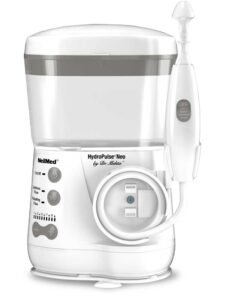From Free Yourself from Sinus and Allergy Problems –Permanently By Murray Grossan, M.D.
From Free Yourself from Sinus and Allergy Problems –Permanently
By Murray Grossan, M.D.
Where and what are the sinuses in the Head? Why do they hurt?
Maxillary Sinuses
The maxillary sinuses are below the eyes, and above the teeth,; and they are the ones most commonly affected in the most serious sinus infection. That’s also the name of the bone in which they are located—, the maxillary bone. They are the largest of the sinuses. Nerves to the teeth, called the inferior alveolar nerve, travel through the maxillary sinus, and it is hard to know if the pain is from a tooth or sinus or both. Often, a toothache feels just like the pain from a sinus infection. An X-ray may be the only way to tell the source of the pain. The right and left maxillary sinuses are equally subject to infection; statistically both right and left are usually involved in an infection.
Nerves
Nerves that give sensation to the cheek also travel through the upper part of the maxillary sinus, and so numbness of the cheek can be from a sinus condition or an orbital fracture.This particular nerve is called the infraorbital nerve. It exits to the surface in the upper 1/3 of the front wall of the maxillary sinus. The term infraorbital refers to under the eye.
Sinus Pain
If you have a maxillary sinus infection, you feel better lying down. Often, a mild pain medication will give pain relief. The cheek may be swollen. There is a greater amount of pus in your nose than with other sinus conditions. Because the size of the maxillary sinus is large, a greater number of bacteria can accumiulate there. There is more drainage of pus to the chest, with cough and voice effects. The maxillary sinus openings may be blocked from nasal polyps or swollen nasal tissue. Blockage of these drainage openings results in purulent infection because the bacteria remain in the closed sinus and multiply.
In this book you will learn the simple logic of washing away bacteria so the body can self- heal. You will learn how pulse wave irrigation can overcome the various films, covers, and other defenses that bacteria have developed against antibiotics. You will learn how cilia defend the sinuses.
In the days before we had antibiotics, every effort was made to drain the pus, to reduce the number of bacteria in the body. Then antibiotics came along and doctors forgot about sinus irrigation. Now antibiotics are losing their effectiveness and the importance of washing away the bacteria is once again recognized. My publications in the 70’s reminded the doctors of the importance of using pulse wave irrigation for this.
Children and Maxillary Sinusitis
In children the maxillary sinuses are fully developed and serious sinus infection can develop here. Drainage, usually by Proetz Sinus Irrigation can be very effective. This will be detailed in the book later.
Double Vision
The top of the maxillary sinus, its roof, forms the floor of the eye socket. If there is a fracture of the maxillary bone, and the roof caves in, then the patient will develop double vision because the eyes are no longer at the same eye level. It is necessary in these patients to do surgery to replace that floor , put the globe in the right place, to fix double vision. The main opening of the maxillary sinus is located between the middle and inferior turbinates
Why Irrigation
Normally liquid drains out of the maxillary sinus via the space between the middle and inferious turbinates. To drain infected material out of this area, you need a steady flow of liquid. A scientific principle called Bernoulli principle shows that the steady flow of liquid past a narrow opening creates a vacuum. This is why short action pots and squeeze bottles are not effective; their flow is irregular and too short. With pulse wave irrigation from a large basin, for example the Hydro Pulse® basin holds half a liter, you have a “lengthy” flow, enough to get a good vacuum. But when you add the pulsing action, this adds to the vacuum like a pump to displace the sinus contents.
Prevention
The best way to avoid a maxillary sinus infections is to avoid blowing your nose too hard. Hard blowing irritates the nasal tissues and forces infected material into the sinuses. Another preventer is to keep nasal cilia moving with tea, lemon and honey and humming.
Surgery
Surgery today is performed using telescopes that visualize the sinus pathology. Frequently small biting instruments are used to enlarge the natural ostia of the sinus. A balloon can be inserted, blown up, the sinus irrigated, and often the opening may remain open. Like any new approach, it will take time to see if this method continues its current popularity.
The key to any sinus surgery success is to get the nasal cilia restored as soon as possible to prevent another sinus infection. If the cilia are not restored quickly, then another infection may take place and the surgery is listed as a poor result!
Complications:
Maxillary sinusitis can affect the teeth, or the eye if the infection breaks through the bony barrier. Anesthesia of the infraorbital or alveolar nerves is another complication. These can be avaoided by early attention to localized sinus pain and fever.

